
02.26.2020
Can AI draw manga? The unprecedented project that recreated the style of Osamu Tezuka, Japan's master of manga. - What is behind the release of the first new Tezuka manga in 31 years? -
- What is behind the release of the first new Tezuka manga in 31 years? -
WHAT IS “TEZUKA 2020”?
“Manga” is a world-renowned form of entertainment that originated in Japan. Known as the “godfather of manga,” Osamu Tezuka influenced many Manga Artists and readers of all ages.
A project was started to commemorate this great creator 30 years after his death. Called “TEZUKA 2020,” it is an effort to create new characters and stories by using AI that has “learned” previous works of Tezuka manga.
The creative team was led by Macoto Tezka, visualist and director of Tezuka Productions. He is a film director and artist engaged in the production of a wide range of content. He directed the animated version of “Black Jack,” one of Osamu Tezuka’s best-known works. As his eldest son, Macoto, has intimate knowledge of Osamu Tezuka’s personality and way of thinking.
The project promoter is Ryohei Orihara. Having worked with AI for more than 30 years, he is currently tasked with utilizing AI to boost productivity at the global semiconductor giant KIOXIA, which makes high-capacity flash memory used in various applications, ranging from smartphones to data centers.
It is said that the development of AI technology will bring about a new world, a world where AI replaces humans and only “human-only tasks” will survive. What will happen to Manga Artists?
We sat down with three people, including business designer Tomoe Ishizumi, who led AI projects at Google and now is at the forefront of the AI industry as CEO of Palo Alto Insight, to talk about the potential of AI in the creative space while looking back on “TEZUKA 2020.”
What if Osamu Tezuka were still alive?
──How did you feel when you heard about the “TEZUKA 2020” project? What did you think?
Macoto Tezka: I was surprised. In fact, I had been wondering if I could use technology to create new Osamu Tezuka manga.
About six years ago, there was a project to make a manga called “Atom the Beginning” based on the original “Astro Boy” idea, and I participated as an editorial supervisor. It was a story about the people who made the robots, and AI appeared in the story. So I had a lot of opportunities to talk to experts in this field.
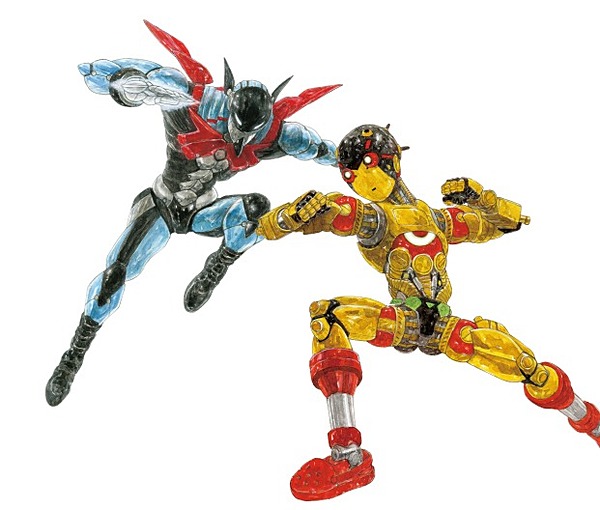
Then an expert asked me, “If AI could take on this challenge and create a new Osamu Tezuka manga, do you think we could get away with it?”
I had a lot of thoughts about using technology to recreate the style of a deceased artist, but I always wanted to do it if there were people out there who would enjoy it.
But the reality is that we needed the cooperation of AI experts and corporate support in order to develop the technology required for production. This was when KIOXIA told us about the TEZUKA 2020 project.

Visualist
Ryohei Orihara: KIOXIA changed its name from “Toshiba Memory” in October 2019. KIOXIA has made a fresh start by shifting its focus from “recording” devices that only accumulate the past, to “memory” devices that create excitement for the future. In order to raise the profile of the new KIOXIA, we started with a new challenge titled “#FUTURE MEMORIES.” TEZUKA 2020 was our first project under this challenge.
If you were to pick one art form to represent Japan, it’s got to be manga. When I was thinking about the manga that I wanted to read again and that had remained in our collective memory, the first thing that came to mind was Osamu Tezuka’s manga.
“If Osamu Tezuka were alive today, what kind of future would he draw in his manga?” It’s a question with a kind of a dream attached to it, and in answer, we converted Tezuka’s work into data and deployed the high-speed, large-capacity memory that is KIOXIA’s strength, as well as advanced AI technology. That is the challenge of this project.

Digital Process Innovation Center
Senior Fellow(Ph.D)
KIOXIA
AI comes up with the crucial “story”
──What was the role of AI in making the manga?
Ryohei Orihara: Manga is made up of a number of elements, like story, characters, and frame layouts, and there are many separate processes in production.
So which processes can be done by AI? We discussed this with our team’s AI experts, Hitoshi Matsubara, the vice president of Future University Hakodate, Kazushi Mukaiyama, a professor at the School of Systems Information Science, and Satoshi Kurihara, a professor at Keio University. As a result of our discussion, we came to the conclusion that it would be difficult to do the entire production with the current level of AI and that collaboration with human beings would be required.
We wanted AI to be the main creative force, and we wanted to use AI for as many processes as possible, so we tasked the AI with drawing up the original story and characters. Then we established a system where people assisted the AI with these tasks.
Tomoe Ishizumi: It’s interesting to see how the elements of manga were broken down. I was also surprised that the story was created by AI.

CEO, Palo Alto Insight
Macoto Tezka: You would normally think that humans would be in charge of that part, but we believed in the potential of AI and went the other way.
As one step in production, we converted Osamu Tezuka’s past works into data, and the AI learned the unique qualities of Osamu Tezuka’s manga in terms of story and characters.
Humans confirmed the results, gave the AI feedback on the unique, “Osamu Tezuka” qualities, and then human creators expanded on the AI’s ideas and created a new work based on the draft generated by the AI.
In terms of story, the AI learned Osamu Tezuka’s worldview, his historical background, and characters appearing in his works, which had been analyzed and converted into data by human beings, and the AI generated a plot based on that worldview, Tezuka’s storylines, and characters. Based on this plot, humans created scenarios by expanding on it.
Ryohei Orihara: The plot the AI created was just one piece of paper long, so that wasn’t enough.
The text wasn’t very clean. Really, it was just a list of keywords. That’s why the creators tidied the plot up and added necessary elements.
We have created 129 stories in total. From them, the new manga Phaedo was born. The story is set in Tokyo in 2030, where the philosopher “Phaedo” and the small bird robot “Apollo” work together to solve various cases.
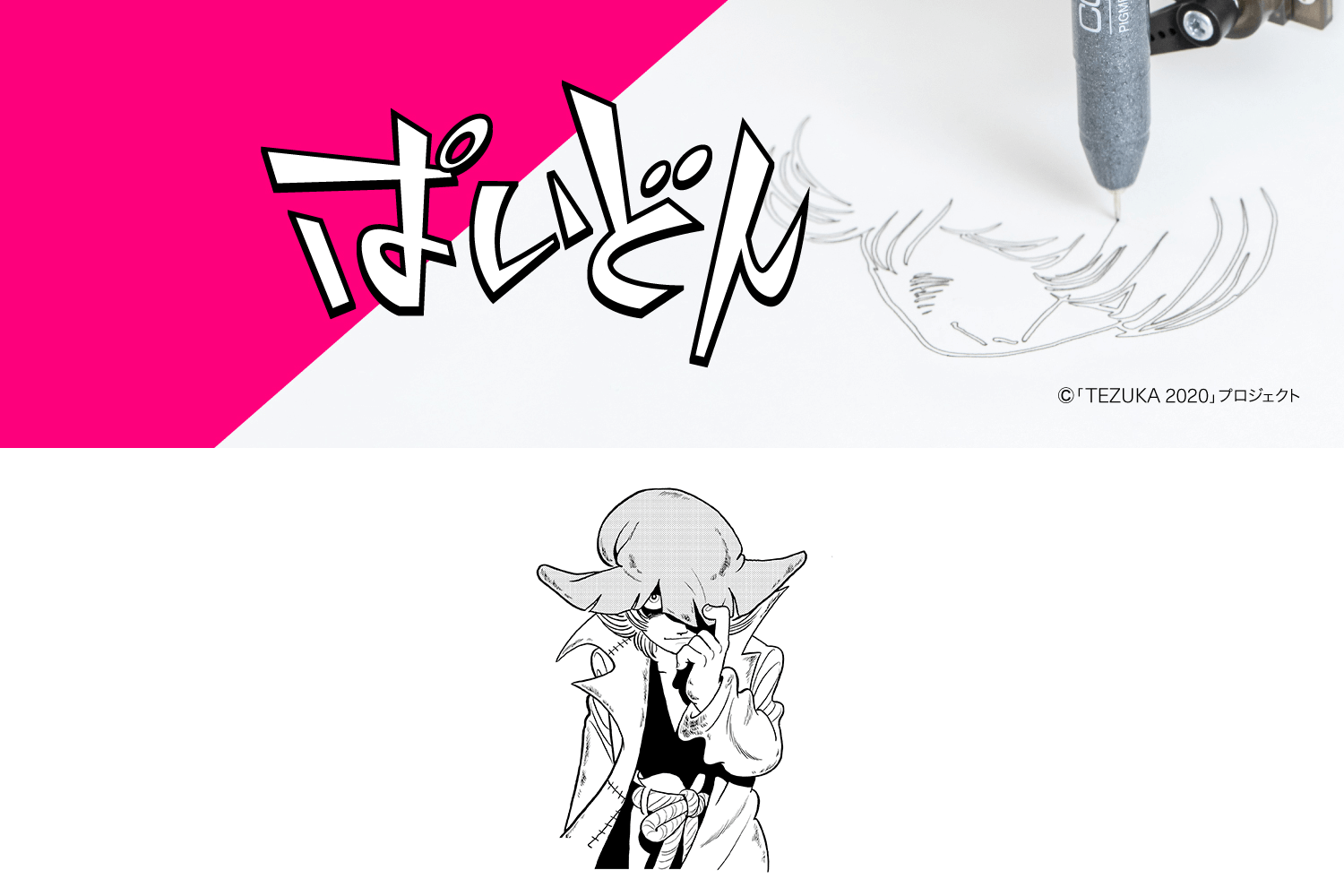
Tomoe Ishizumi: It’s a true collaboration between AI and humans. My position is to introduce AI into the business domain, and I believe that if the strengths of AI and human beings can be combined effectively, it will produce an exponentially greater effect, more than just 1+1=2. I thought it was really amazing that we were able to achieve this in a creative field.
Macoto Tezka: For the characters, the faces were extracted from scans of Osamu Tezuka’s works, and the AI was trained on those faces. Then, the face images of our new characters were generated by the AI. From the face images, humans developed character designs, including the clothes, in accordance with the scenario.
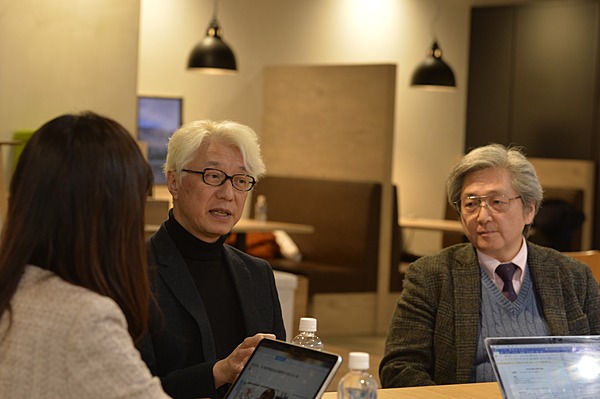
AI doesn’t recognize “Professor Ochanomizu” as a human being
Tomoe Ishizumi: One of the most famous examples of pictures created by AI is the reproduction of the works of Rembrandt, a painter from the 17th century. In 2016, an AI reproduced the characteristics of Rembrandt’s paintings and created a new three-dimensional painting using a 3D printer.
One of the algorithms that are often used in image generation is “GAN.” GAN is an algorithm that can identify the characteristics of an image by itself and automatically generate another image, rather than being taught the characteristics of the image by humans.
Ryohei Orihara: KIOXIA also uses it for design support, but designing manga characters is a completely different task.
Normally, GAN needs to read tens of thousands mage data. I thought we could use GAN because there was a lot of data in Tezuka Productions, but we were only able to use a few thousands data.
Of course, there are many character images in Osamu Tezuka’s works. However, the details and forms of the characters differed between his various works. We decided to use “Black Jack” and “The Three-Eyed One,” which were published in the 1970s and serialized for many years, to extract data. As a result, we could use only a few thousands image data.
Macoto Tezka: One of the great things about humans is that we can look at the characters in a manga and can recognize them as human beings. It’s obvious in Rembrandt’s paintings that the subjects are humans.
But let’s think about “Professor Ochanomizu,” who often appears in Osamu Tezuka’s manga. In the real world, there are no human beings that have a nose as big as his. “Atom,” on the other hand, has a completely different shape, even though he appears in the same manga. So it is difficult to get the AI to learn different characters by mixing them up.

Ryohei Orihara: And in manga, there aren’t many scenes where characters are facing front. We tried to use technology to augment the data, but it didn’t work. Next, we used a technology for transferring learning data other than manga. We tried StyleGAN, which we had never used in our business before.
As mentioned previously, “Professor Ochanomizu” does not look like a real human being. So we decided to start by making the AI look at photographs of humans and then pictures of characters, hoping that eventually the AI would be able to produce images that would look somewhat like human faces.
Macoto Tezka: Up to that point, we had only been able to create images that looked like patterns, and these were far from recognizable as human faces. However, after the AI studied the images of human faces, it started to produce the faces that had the characteristics of a Tezuka manga.
Please have a look. The images of the face gradually change moment by moment, but every image has the Osamu Tezuka look.
What’s more, one character image looks very much like Osamu Tezuka’s “Shumari” character, but we didn’t actually use Shumari as training data. In other words, the AI learned about other characters, and even though images of Shumari were not given to the AI, it pretty much reproduced the Shumari, just as Osamu Tezuka had designed him.
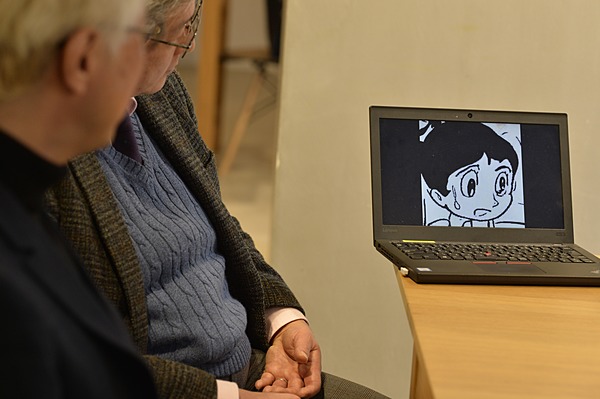
Tomoe Ishizumi: Wow!
A collaboration of over 50 creators and engineers
──How long did the project take?
Macoto Tezka: About half a year.
Tomoe Ishizumi: Only six months …
Macoto Tezka: University professors who have developed basic research in this field for many years, a number of students, engineers from KIOXIA and dozens of creators from Tezuka Productions got together to work on the project.
More than 50 professionals were involved, and Professor Kurihara said, “This is the first project where this many people can work autonomously.”

Tomoe Ishizumi: Preparing the training data for the AI is really hard, isn’t it? It is wonderful that a project of this scale was completed within a short period of time and that the creative team and the engineering team collaborated so well.
In order to generate the face changing graphics, I would imagine a high-performance machine was required. In my experience, it’s difficult to use cloud computing with general capabilities, and we ended up spending a lot of money to build our own equipment and environment.
Ryohei Orihara: We asked Professor Kurihara to examine the generative AI technology, but we needed a lot of computing power to run the project at this scale. That’s why we decided to use a high-performance machine provided by KIOXIA for intensive computation. I’m glad we could help.
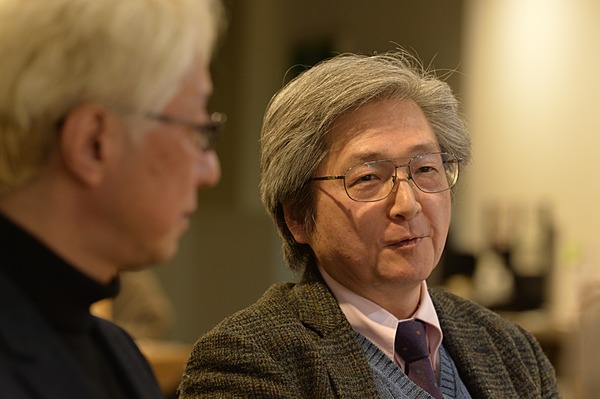
I’ve been working on research on AI and creativity support, so I was really grateful that I could achieve something that I had always wanted to do personally.
Macoto Tezka: This was a project that would not have been possible without support from the corporate sector.
Tomoe Ishizumi: There are pros and cons to using AI to recreate the work of deceased artists, but I haven’t heard anything critical about the reproduction of Rembrandt’s works.
I think what is important is that it has emotional value. It’s exciting that we could reproduce what Osamu Tezuka would have done, and I’m also impressed with the infrastructure technology that supported the reproduction.

The form of a truly co-creative relationship
──This project demonstrated a new kind of collaborative relationship between humans and AI in the creative field.
Macoto Tezka: You might say that only people can be creative, but I don’t think so. Having said that, I also think it is difficult to create works of art that people would find appealing using technology alone.
While this may be the same for innovation, in the creative field, we can’t create a work from scratch or from a place where there is nothing at all. Instead, we can create new value and new excitement by combining existing things.
In this sense, it is important to apply human sensitivity in deciding what to combine, but it’s also crucial to gather the right type of information. This is an area where AI and other technologies can offer a lot of support.
My feeling is that it is not until there is a sense of purpose and sensitivity that “perfection” becomes possible. The machine doesn’t have these, so I don’t think machines can create something that is truly “perfect.” I think we can create perfect works by having machines support things that reflect human sensitivity.
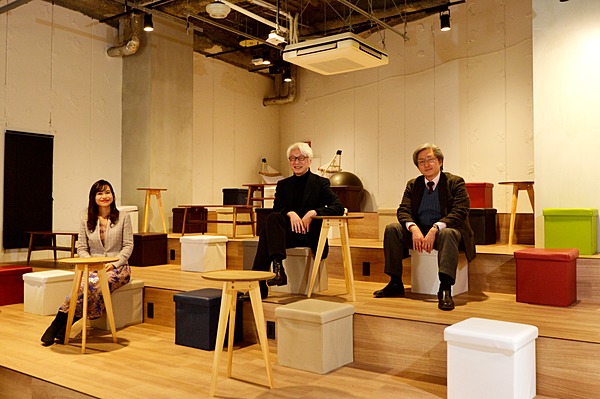
Tomoe Ishizumi: With the spread of AI-powered creativity support tools, there will be more creative people.
And I think creators can become “super creators” by using automation. Manga artist will also be able to spend more time on important, and certainly necessary, areas like the creation of a vision.
Ryohei Orihara: As the scope of these projects expands, I think we will have a better understanding of what really needs to be done by human or what creativity really means.
Macoto Tezka: As a creator, I don’t want to define the areas that only people can do. Instead, I want to take the lead in researching the areas where technology can be applied and explore the areas where people should take responsibility and where people can inspire.

Macoto Tezka
Visualist
Macoto Tezka was born in Tokyo in 1961. When Macoto was a high school student, he started making 8 mm films and was highly praised by filmmakers such as director Nagisa Oshima. While at university, Macoto started to be actively involved in various media, including movies, TV and videos. While focused on movies, he also produced novels, digital software, events and CDs, attracting attention for the advanced style of his content. In 1999, the theatrical film “Hakuchi” (The Innocent), directed by Macoto, was shown at the Venice International Film Festival and others and gained international acclaim. His new movie “Barbara” will be released in 2020.
Ryohei Orihara
Digital Process Innovation Center
Senior Fellow(Ph.D)
KIOXIA
Ryohei Orihara was born in Tokyo in 1963. After completing master’s degree in University of Tsukuba, he was involved in researches of creativity support system, analogical reasoning, machine learning, and data and text mining in Toshiba. While at Toshiba, he was enrolled in University of Toronto as a visiting researcher from 1993 to 1995. After joining Toshiba memory (currently called as KIOXIA) in 2019, he was engaged in productivity improvement of the process of manufacturing semiconductors as a Senior Fellow in Digital Process Innovation Center. He also teaches in University of Electro-Communications as a visiting professor and served as vice president of the Japanese Society for Artificial Intelligence from 2017 to 2019.
Tomoe Ishizumi
CEO, Palo Alto Insight
After obtaining an MBA from Harvard Business School in 2010, Tomoe led several AI projects while at Google’s headquarters. She was then involved in setting up an HR tech venture and a logistics AI venture before founding Palo Alto Insight in 2017. Tomo provides Japanese enterprises with one-stop services ranging from the proposal of AI strategies to AI implementation. She is also a sought-after speaker on the topics of AI & business, Silicon Valley an IT companies, new work styles and the advancement of women. She is the author of What lies ahead of AI? (Discover 21, Inc.)
Interview and editorial: Takeshi Kimura
Composition: Norihiro Kato
Photoshoot: Kazushige Mori
Design: Kyosuke Tsukimori
The content and profile are current as of the time of the interview (February 2020).



